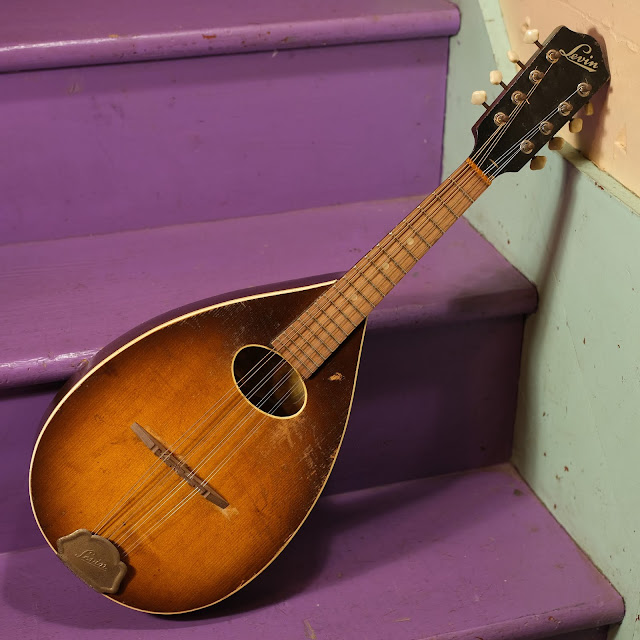1954 Levin Model 54 "Taranto" Flatback Mandolin
Update 2020: I've updated this entire blog post with new pics, a new video, and new description.
The vintage Levin guitars website gave me the information needed to peg this as both a '54 per its serial number (at the top of the headstock) and as a Model 54 per its styling and features. It was made in Sweden by said Levin company (we most-often come across their Goya classical guitars of the '50s and '60s over here) and, despite being a bit rough around the edges, is quite a nice little mando with and outsized voice for its size.
Soundwise, it has a woody, folksy, clean sound and good punch/forward carrying-power. It's not choppy like a bluegrass mandolin but it'll definitely bounce above a few guitars and a bass in a jam situation. It has enough wear and tear to make it "folksy" and approachable but the "love" has been done so that it plays bang-on and quick.
There'd been previous work done to this when I initially got it -- some repaired cracks to the bass-side and a filled long hairline crack on the back -- but I reinforced and cleated these where necessary and then did my own set of work on it. It came back to me just as it left -- ready to go -- and I'd recently restrung it and set it up again, too.
Repairs included: a board plane and refret, side dots, new compensated rosewood bridge, cleating to the old back crack repair, general cleaning, perhaps a brace repair or two, and setup.
Setup notes: it plays perfectly with a straight neck and 1/16" action at the 12th fret. Strings are gauged 32w-9 and are the GHS A240 set. I think 10s would be fine on it, but the 9s feel slick and give plenty of oomph.
Scale length: 13 1/4"
Nut width: 1 1/8"
String spacing at nut: 15/16"
String spacing at bridge: 1 11/16"
Body length: 12 3/4"
Top width: 8 5/8"
Side depth: 2 3/8"
Top wood: solid spruce
Back/sides wood: solid birch
Bracing type: ladder
Fretboard: unsure, butternut or European walnut?
Bridge: rosewood, comp'd
Neck feel: medium C-shape, flat board
Condition notes: there are a cluster of repaired hairline cracks on the bass-side (pictured) and a long repaired one on the back. There's plenty of pickwear, usewear, and random nicks, dings, scuffs, and scratches throughout. The frets are much nicer than the originals but are replaced. The tuner buttons are cool but have shrunk a bit -- though they're still going strong. The bridge is a replacement but better than what would've been on it to begin with.
It comes with: a modern, no-frills, black hard case (not pictured but in good order).

















Comments
I picked up one of these a couple days ago. All good, but I can just reach the brace under the bridge and it is not as tall as those north & south of the sound hole. Do you recall if this was the case with this model you worked on? Wondering if they had a lighter brace under the bridge or if a piece split off clean in the one I now have, if the latter then will have to have it addressed for the top doesn't collapse.
Thanks!